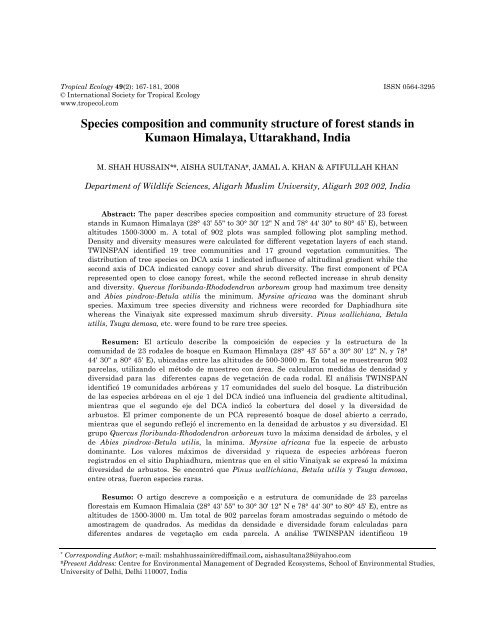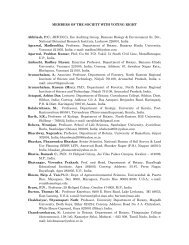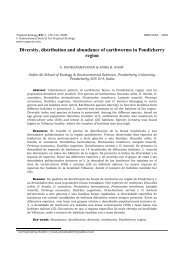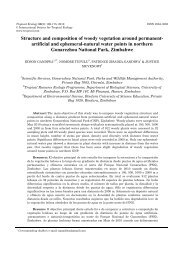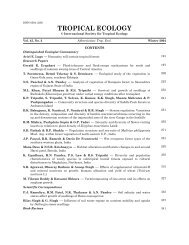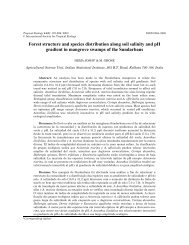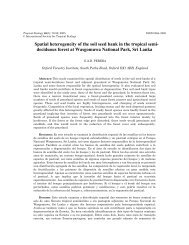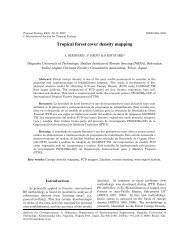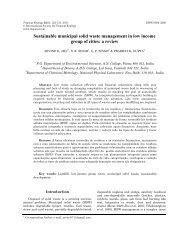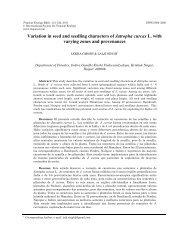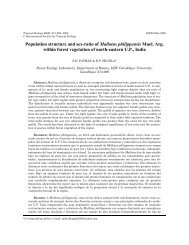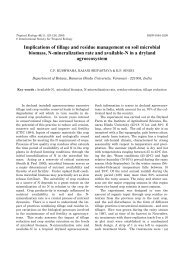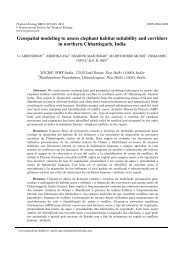Species composition and community structure of forest stands in ...
Species composition and community structure of forest stands in ...
Species composition and community structure of forest stands in ...
You also want an ePaper? Increase the reach of your titles
YUMPU automatically turns print PDFs into web optimized ePapers that Google loves.
HUSSAIN et al. 167<br />
Tropical Ecology 49(2): 167-181, 2008 ISSN 0564-3295<br />
© International Society for Tropical Ecology<br />
www.tropecol.com<br />
<strong>Species</strong> <strong>composition</strong> <strong>and</strong> <strong>community</strong> <strong>structure</strong> <strong>of</strong> <strong>forest</strong> st<strong>and</strong>s <strong>in</strong><br />
Kumaon Himalaya, Uttarakh<strong>and</strong>, India<br />
M. SHAH HUSSAIN* #, AISHA SULTANA #, JAMAL A. KHAN & AFIFULLAH KHAN<br />
Department <strong>of</strong> Wildlife Sciences, Aligarh Muslim University, Aligarh 202 002, India<br />
Abstract: The paper describes species <strong>composition</strong> <strong>and</strong> <strong>community</strong> <strong>structure</strong> <strong>of</strong> 23 <strong>forest</strong><br />
st<strong>and</strong>s <strong>in</strong> Kumaon Himalaya (28° 43' 55" to 30° 30' 12" N <strong>and</strong> 78° 44' 30" to 80° 45' E), between<br />
altitudes 1500-3000 m. A total <strong>of</strong> 902 plots was sampled follow<strong>in</strong>g plot sampl<strong>in</strong>g method.<br />
Density <strong>and</strong> diversity measures were calculated for different vegetation layers <strong>of</strong> each st<strong>and</strong>.<br />
TWINSPAN identified 19 tree communities <strong>and</strong> 17 ground vegetation communities. The<br />
distribution <strong>of</strong> tree species on DCA axis 1 <strong>in</strong>dicated <strong>in</strong>fluence <strong>of</strong> altitud<strong>in</strong>al gradient while the<br />
second axis <strong>of</strong> DCA <strong>in</strong>dicated canopy cover <strong>and</strong> shrub diversity. The first component <strong>of</strong> PCA<br />
represented open to close canopy <strong>forest</strong>, while the second reflected <strong>in</strong>crease <strong>in</strong> shrub density<br />
<strong>and</strong> diversity. Quercus floribunda-Rhododendron arboreum group had maximum tree density<br />
<strong>and</strong> Abies p<strong>in</strong>drow-Betula utilis the m<strong>in</strong>imum. Myrs<strong>in</strong>e africana was the dom<strong>in</strong>ant shrub<br />
species. Maximum tree species diversity <strong>and</strong> richness were recorded for Daphiadhura site<br />
whereas the V<strong>in</strong>aiyak site expressed maximum shrub diversity. P<strong>in</strong>us wallichiana, Betula<br />
utilis, Tsuga demosa, etc. were found to be rare tree species.<br />
Resumen: El artículo describe la composición de especies y la estructura de la<br />
comunidad de 23 rodales de bosque en Kumaon Himalaya (28° 43' 55" a 30° 30' 12" N, y 78°<br />
44' 30" a 80° 45' E), ubicadas entre las altitudes de 500-3000 m. En total se muestrearon 902<br />
parcelas, utiliz<strong>and</strong>o el método de muestreo con área. Se calcularon medidas de densidad y<br />
diversidad para las diferentes capas de vegetación de cada rodal. El análisis TWINSPAN<br />
identificó 19 comunidades arbóreas y 17 comunidades del suelo del bosque. La distribución<br />
de las especies arbóreas en el eje 1 del DCA <strong>in</strong>dicó una <strong>in</strong>fluencia del gradiente altitud<strong>in</strong>al,<br />
mientras que el segundo eje del DCA <strong>in</strong>dicó la cobertura del dosel y la diversidad de<br />
arbustos. El primer componente de un PCA representó bosque de dosel abierto a cerrado,<br />
mientras que el segundo reflejó el <strong>in</strong>cremento en la densidad de arbustos y su diversidad. El<br />
grupo Quercus floribunda-Rhododendron arboreum tuvo la máxima densidad de árboles, y el<br />
de Abies p<strong>in</strong>drow-Betula utilis, la mínima. Myrs<strong>in</strong>e africana fue la especie de arbusto<br />
dom<strong>in</strong>ante. Los valores máximos de diversidad y riqueza de especies arbóreas fueron<br />
registrados en el sitio Daphiadhura, mientras que en el sitio V<strong>in</strong>aiyak se expresó la máxima<br />
diversidad de arbustos. Se encontró que P<strong>in</strong>us wallichiana, Betula utilis y Tsuga demosa,<br />
entre otras, fueron especies raras.<br />
Resumo: O artigo descreve a composição e a estrutura de comunidade de 23 parcelas<br />
florestais em Kumaon Himalaia (28° 43' 55" to 30° 30' 12" N e 78° 44' 30" to 80° 45' E), entre as<br />
altitudes de 1500-3000 m. Um total de 902 parcelas foram amostradas segu<strong>in</strong>do o método de<br />
amostragem de quadrados. As medidas da densidade e diversidade foram calculadas para<br />
diferentes <strong>and</strong>ares de vegetação em cada parcela. A análise TWINSPAN identificou 19<br />
* Correspond<strong>in</strong>g Author; e-mail: mshahhussa<strong>in</strong>@rediffmail.com, aishasultana28@yahoo.com<br />
#Present Address: Centre for Environmental Management <strong>of</strong> Degraded Ecosystems, School <strong>of</strong> Environmental Studies,<br />
University <strong>of</strong> Delhi, Delhi 110007, India
168 FOREST STRUCTURE IN KUMAON HIMALAYA<br />
comunidades arbóreas e 17 comunidades de vegetação rasteira. A distribuição das espécies<br />
arbóreas no eixo DCA <strong>in</strong>dicam a covertura pelo copado e a diversidade dos arbustos. A primeira<br />
componente do ACP representou florestas com copado aberto a fechado, enquanto a segunda<br />
reflectiu o aumento na densidade e diversidade dos arbustos. O grupo Quercus floribunda-<br />
Rhododendron arboreum apresentou a densidade arbórea máxima e o Abies p<strong>in</strong>drow-Betula<br />
utilis o mínimo. A Myrs<strong>in</strong>e africana foi a espécie arbustiva dom<strong>in</strong>ante. A diversidade arbórea<br />
máxima e riqueza foi registada para a estação Daphiadhura enquanto a estação V<strong>in</strong>aiyak<br />
expressou a diversidade arbustiva máxima. Encontrou-se que a P<strong>in</strong>us wallichiana, Betula<br />
utilis, Tsuga demosa, etc. eram espécies arbóreas raras.<br />
Key words: Forest conservation, Himalaya, Himalayan <strong>forest</strong>s, India, ord<strong>in</strong>ation,<br />
rare species, vegetation <strong>community</strong>.<br />
Introduction<br />
Himalaya, the youngest mounta<strong>in</strong> system <strong>of</strong><br />
the world, constitutes an important l<strong>in</strong>k between<br />
the vegetation <strong>of</strong> the southern pen<strong>in</strong>sular India<br />
on the one h<strong>and</strong>, the eastern Malaysian, the<br />
north-eastern S<strong>in</strong>o-Japanese <strong>and</strong> the northern<br />
Tibetan areas on the other (Puri et al. 1983).<br />
Several studies have described the vegetation <strong>of</strong><br />
Kumaon (Dhar et al. 1997; Rikhari et al. 1989a;<br />
S<strong>in</strong>gh et al. 1984; S<strong>in</strong>gh & S<strong>in</strong>gh 1984; S<strong>in</strong>gh &<br />
S<strong>in</strong>gh 1987; S<strong>in</strong>gh et al. 1987; Tiwari & S<strong>in</strong>gh<br />
1985; Upreti et al. 1985) <strong>and</strong> Garhwal Himalaya<br />
(Anthwal et al. 2006; Kumar & Bhatt 2006;<br />
Nautiyal et al. 2004). Some <strong>of</strong> the studies<br />
described altitud<strong>in</strong>al variation <strong>in</strong> vegetation<br />
(Adhikari et al. 1992; Saxena et al. 1985) <strong>and</strong><br />
reported that vegetation types differ with change<br />
<strong>in</strong> altitude. However, Puri et al. (1983) observed<br />
that geology <strong>and</strong> soils may exercise a far greater<br />
<strong>in</strong>fluence on the distribution <strong>of</strong> vegetation types<br />
than the altitude or climate.<br />
Some pioneer<strong>in</strong>g contributions on<br />
phytosociology (Ralhan et al. 1982; Saxena &<br />
S<strong>in</strong>gh 1982) <strong>and</strong> population <strong>structure</strong> (Saxena et<br />
al. 1985; S<strong>in</strong>gh et al. 1987) <strong>of</strong> certa<strong>in</strong> central<br />
Himalayan <strong>forest</strong> types have already been<br />
reported. The ma<strong>in</strong> objectives <strong>of</strong> this paper are: (i)<br />
to describe structural attributes (density, species<br />
diversity <strong>and</strong> richness) <strong>of</strong> tree, shrub <strong>and</strong> ground<br />
layers; (ii) to identify predom<strong>in</strong>at<strong>in</strong>g communities<br />
<strong>of</strong> trees <strong>and</strong> ground vegetation, <strong>and</strong> plant species<br />
<strong>of</strong> special concern, <strong>and</strong> to further identify the<br />
localities hav<strong>in</strong>g rare plant communities need<strong>in</strong>g<br />
protection.<br />
Materials <strong>and</strong> methods<br />
Study area<br />
The study was conducted <strong>in</strong> 23 <strong>forest</strong> st<strong>and</strong>s<br />
<strong>in</strong>clud<strong>in</strong>g B<strong>in</strong>sar Wildlife Sanctuary (BWS) <strong>and</strong><br />
Askot Wildlife Sanctuary (AWS), <strong>in</strong> five districts;<br />
Almora, Bageshwer, Champawat, Na<strong>in</strong>i Tal <strong>and</strong><br />
Pithoragarh <strong>of</strong> Kumaon Himalaya (28° 43' 55" to<br />
30° 30' 12" N latitude <strong>and</strong> 78° 44' 30" to 80° 45' E<br />
longitude) cover<strong>in</strong>g an area <strong>of</strong> 21,032 km² <strong>in</strong> the<br />
Uttarakh<strong>and</strong> state <strong>of</strong> India (Fig. 1, Table 1).<br />
Kumaon Himalaya is altitud<strong>in</strong>ally divisible <strong>in</strong>to<br />
subtropical (300 to 1500 m), temperate (1500 to<br />
3500 m) <strong>and</strong> alp<strong>in</strong>e (>3500 m) zones (Saxena et al.<br />
1985). Annual ra<strong>in</strong>fall peaks at about 1200 m<br />
altitude (4100 mm) <strong>and</strong> gradually decl<strong>in</strong>es to 670<br />
mm at 2700 m (Saxena et al. 1985).<br />
Sampl<strong>in</strong>g procedures<br />
Overall 902 sampl<strong>in</strong>g plots were laid <strong>in</strong> the 23<br />
<strong>forest</strong> st<strong>and</strong>s (details <strong>in</strong> Table 1). Vegetation was<br />
sampled along exist<strong>in</strong>g <strong>forest</strong> trails which passed<br />
through all the major habitat types to permit<br />
sampl<strong>in</strong>g <strong>of</strong> different habitats <strong>in</strong> equal proportion<br />
at each site. In each st<strong>and</strong>, sampl<strong>in</strong>g plots were 50<br />
m apart, <strong>and</strong> each was laid at a distance <strong>of</strong> 10 m<br />
from the edge <strong>of</strong> the trail on either side to avoid<br />
sampl<strong>in</strong>g <strong>of</strong> the relatively disturbed vegetation.<br />
Number <strong>of</strong> plots sampled <strong>in</strong> different st<strong>and</strong>s is<br />
given <strong>in</strong> Table 1.<br />
At each sampl<strong>in</strong>g plot, a 10 m radius circular<br />
plot (Dombois & Ellenberg 1974) was established.<br />
Trees > 4 m height were considered mature trees.<br />
<strong>Species</strong> <strong>and</strong> their <strong>in</strong>dividuals were recorded for the
estimation <strong>of</strong> density, species diversity <strong>and</strong> species<br />
richness. Shrub layer was quantified <strong>in</strong> 3 m radius<br />
circular plots whereas ground vegetation (herbs<br />
<strong>and</strong> grasses) was estimated <strong>in</strong> 0.5 m x 0.5 m<br />
quadrats at four places with<strong>in</strong> the 10 m radius<br />
sampl<strong>in</strong>g plot. Tree cover was measured at 5 m<br />
HUSSAIN et al. 169<br />
Fig 1. Location <strong>of</strong> 23 surveyed <strong>forest</strong> st<strong>and</strong>s <strong>in</strong> Kumaon Himalaya.<br />
distance from the sampl<strong>in</strong>g po<strong>in</strong>t <strong>in</strong> four different<br />
directions us<strong>in</strong>g gridded mirror <strong>of</strong> 25.4 x 25.4 cm<br />
(10 x 10 <strong>in</strong>ch) dimension, divided <strong>in</strong>to 25 equal<br />
grids. Grids covered with > 50% foliage were<br />
counted <strong>and</strong> expressed <strong>in</strong> terms <strong>of</strong> percent tree<br />
cover (Dombois & Ellenberg 1974).
170 FOREST STRUCTURE IN KUMAON HIMALAYA<br />
Density <strong>and</strong> diversity estimates<br />
Density <strong>of</strong> trees, shrubs <strong>and</strong> ground vegetation<br />
was calculated follow<strong>in</strong>g Greig - Smith (1983). The<br />
diversity values for each layer (tree, shrub <strong>and</strong><br />
ground vegetation) were calculated us<strong>in</strong>g Shannon<br />
- Wiener’s diversity <strong>in</strong>dex follow<strong>in</strong>g Magurran<br />
(1988). The species richness was calculated us<strong>in</strong>g<br />
Margelef’s species richness <strong>in</strong>dex (Magurran<br />
1988). One-way ANOVA (Zar 1984) was used to<br />
detect significant differences <strong>in</strong> density, diversity<br />
<strong>and</strong> richness for the vegetation layers <strong>in</strong> all the<br />
surveyed <strong>forest</strong> st<strong>and</strong>s.<br />
Classification <strong>and</strong> ord<strong>in</strong>ation <strong>of</strong> species <strong>and</strong><br />
sites<br />
The vegetation was classified on the basis <strong>of</strong><br />
tree species <strong>and</strong> dom<strong>in</strong>ant ground vegetation<br />
(shrub <strong>and</strong> herb species) us<strong>in</strong>g TWINSPAN (Twoway<br />
<strong>in</strong>dicator species analysis) computer program<br />
(Hill 1979 a). Same data matrix was used for<br />
ord<strong>in</strong>ation <strong>of</strong> tree species as well as sites (<strong>forest</strong><br />
st<strong>and</strong>s) through Detrended Correspondence<br />
Analysis (DCA) <strong>in</strong> computer program DECORANA<br />
(Hill 1979 b). The vegetation attributes (density,<br />
diversity <strong>and</strong> richness) <strong>of</strong> the 23 sites along with<br />
altitude, number <strong>of</strong> stumps, lopped trees <strong>and</strong> cattle<br />
dung were subjected to Pr<strong>in</strong>cipal Component<br />
Analysis (PCA).<br />
Stepwise multiple regression was used to<br />
obta<strong>in</strong> correlation between the DCA axes, <strong>and</strong><br />
measured environmental <strong>and</strong> vegetation<br />
attributes. All data matrices were st<strong>and</strong>ardized<br />
follow<strong>in</strong>g Zar (1984) to achieve normality <strong>and</strong><br />
reduce heteroscadesticity.<br />
Rarity <strong>in</strong>dex<br />
A rarity <strong>in</strong>dex was generated to identify rare<br />
tree species <strong>of</strong> Kumaon. For this purpose two<br />
parameters were taken <strong>in</strong>to account-<br />
a) Qualitative proportion <strong>of</strong> each tree species <strong>in</strong><br />
Kumaon (PQA)<br />
Table 1. Location details <strong>and</strong> distribution <strong>of</strong> sampl<strong>in</strong>g plots <strong>in</strong> different <strong>forest</strong> st<strong>and</strong>s <strong>of</strong> Kumaon<br />
Himalaya. RF = Reserve <strong>forest</strong>, POF = Privately owned <strong>forest</strong>, WLS = Wildlife sanctuary, CF =<br />
Community <strong>forest</strong>, Alt. = Altitude, m = meter, asl = above sea level, BWS = B<strong>in</strong>sar Wildlife Sanctuary.<br />
Forest st<strong>and</strong> District Status Sampl<strong>in</strong>g<br />
Plots<br />
Alt. Range<br />
(m asl.)<br />
Coord<strong>in</strong>ates<br />
Kilbery Na<strong>in</strong>i Tal RF 40 2085- 2240 29°25'24.3"N 79°2.6'24.3"E<br />
V<strong>in</strong>aiyak Na<strong>in</strong>i Tal RF 40 2130- 2290 29°27'45.4"N 79°24'31.8"E<br />
Kunjakharak Na<strong>in</strong>i Tal RF 45 2040- 2430 29°39'N 79°18'58.1"E<br />
Maheshkhan Na<strong>in</strong>i Tal RF 40 1820- 2090 29°24'16.2"N 79°33'50.6"E<br />
Gager Na<strong>in</strong>i Tal RF 40 1860- 2220 29°25'11.4"N 79°30'31.9"E<br />
Mukteshwer Na<strong>in</strong>i Tal RF 49 1800- 2260 29°28'34.1"N 79°38'28.1"E<br />
Jill<strong>in</strong>g Na<strong>in</strong>i Tal POF 20 1860- 2010 29°22'1.6"N 79°37'E<br />
BWS Bageshwer WLS 75 1990- 2260 29°42'3.2"N 79°45'E<br />
P<strong>and</strong>avkholi Almora CF 40 2460- 2590 29°48'19.5"N 79°27'E<br />
Sitlakhet Almora RF 15 1880- 1980 29°42'3.2"N 79°45'E<br />
Jageshwer Almora RF 26 2060- 2200 29°39'3.2"N 79°50'52.5"E<br />
Gasi Bageshwer RF 40 2140- 2370 30°04'48.4"N 80°E<br />
Dhakuri Bageshwer RF 55 2470- 2825 30°13'19.5"N 79°55'26.3"E<br />
Wachham Bageshwer RF 50 2410- 2935 30°07'25"N 79°54'37.5"E<br />
Sunderdunga Bageshwer RF 36 2560- 2780 30°13'30.3"N 79°54'18.5"E<br />
P<strong>in</strong>dari Bageshwer CF 39 2200- 2960 30°11'11.3"N 79°59'30"E<br />
Daphiadhura Pithoragarh WLS 40 2020- 2440 29°54'N 80°20'E<br />
Majtham Pithoragarh WLS 40 1595- 2250 29°53'N 80°22'E<br />
G<strong>and</strong>hura Pithoragarh WLS 50 1710- 2045 29°51'40"N 80°14'16.9"E<br />
Sobala Pithoragarh WLS 40 2190- 2650 30°04'16.2"N 80°34'15"E<br />
Duku Pithoragarh WLS 48 1930- 2530 29°56.3'N 80°30'E<br />
Munsiary Pithoragarh RF 25 2655- 2770 30°05'3.2"N 80°14'41.3"E<br />
Mechh Champawat CF 10 1810- 1830 29°16'16.2"N 80°12'18.8"E
(PQA) = Number <strong>of</strong> st<strong>and</strong>s the concerned tree<br />
species was encountered/total number <strong>of</strong> st<strong>and</strong>s (23)<br />
b) Quantitative proportion <strong>of</strong> each tree species <strong>in</strong><br />
Kumaon (PQI)<br />
(a)<br />
(b)<br />
HUSSAIN et al. 171<br />
(PQI) = Number <strong>of</strong> <strong>in</strong>dividuals <strong>of</strong> each tree<br />
species / number <strong>of</strong> <strong>in</strong>dividuals <strong>of</strong> all tree species<br />
where the concerned species was encountered<br />
Rarity <strong>in</strong>dex for each tree species = PQA + PQI<br />
Fig. 2. TWINSPAN classification <strong>of</strong> (a) 63 species <strong>in</strong>to 19 groups based<br />
on the tree species data <strong>of</strong> Kumaon Himalaya, <strong>and</strong> (b) classification <strong>of</strong> 23<br />
surveyed <strong>forest</strong> st<strong>and</strong>s <strong>in</strong>to 8 groups.
172 FOREST STRUCTURE IN KUMAON HIMALAYA<br />
Results<br />
Tree species classification<br />
N<strong>in</strong>eteen broad communities have been<br />
recognised <strong>in</strong> Kumaon. Overall, 63 tree, 56 shrub,<br />
90 herb <strong>and</strong> 21 grass species were recorded <strong>in</strong> the<br />
23 <strong>forest</strong> st<strong>and</strong>s. A total <strong>of</strong> five homogenous groups<br />
<strong>of</strong> tree species, <strong>in</strong> relation to the environmental<br />
variables, was identified through TWINSPAN<br />
analysis (Fig. 2). The left arm <strong>of</strong> the first dichotomy<br />
conta<strong>in</strong>ed 25 species, which was further divided <strong>in</strong>to<br />
two groups. First negative group consisted <strong>of</strong> four<br />
species which were characteristic <strong>of</strong> site 8 (for site<br />
code see Fig 1). Second positive group also consisted<br />
<strong>of</strong> two homogenous groups. The first group<br />
conta<strong>in</strong>ed Quercus semecarpifolia as a dom<strong>in</strong>ant<br />
species at sites 12, 13 <strong>and</strong> 17. The second group<br />
consisted <strong>of</strong> Abies p<strong>in</strong>drow <strong>and</strong> Taxus baccata as<br />
dom<strong>in</strong>ant species <strong>and</strong> represented mixed coniferous<br />
habitat. Further subdivisions did not provide any<br />
additional ecological <strong>in</strong>formation. The right arm <strong>of</strong><br />
the first dichotomy had 38 tree species, which were<br />
further divided <strong>in</strong>to two groups. First negative<br />
group conta<strong>in</strong>ed 21 species. These tree species were<br />
ma<strong>in</strong>ly encountered at sites 2, 4, 5, 7, 18, 19 <strong>and</strong> 23.<br />
At site 2, Q. leucotricophora, P<strong>in</strong>us wallichiana <strong>and</strong><br />
Cedrus deodara were the dom<strong>in</strong>ant tree species<br />
while at site 23 the dom<strong>in</strong>ant species was Q.<br />
lanug<strong>in</strong>osa (Table 2).<br />
Tree species ord<strong>in</strong>ation<br />
DCA ord<strong>in</strong>ation successfully h<strong>and</strong>led the<br />
variation <strong>in</strong> tree species communities from low to<br />
high altitude. All the sites <strong>and</strong> tree species showed<br />
mean<strong>in</strong>gful distribution on axis 1 <strong>and</strong> axis 2 <strong>of</strong><br />
DCA (Fig. 3 a). The first axis (eigen value = 0.389)<br />
represents an altitude gradient (low to high). Sites<br />
14, 15, 16, 20, 21, <strong>and</strong> 22 occupied extreme end <strong>of</strong><br />
the first axis <strong>and</strong> represented TWINSPAN group 3<br />
(A. p<strong>in</strong>drow, T. baccata, Betula utilis, Tsuga<br />
Table 2. Communities <strong>and</strong> their characteristic tree species with their codes (<strong>in</strong> parentheses used <strong>in</strong><br />
DECORANA computer program) <strong>in</strong> Kumaon based on TWINSPAN classification. Comm. = Community.<br />
Groups Comm. Forest st<strong>and</strong> Tree species<br />
1 1 BWS Acer caesium (20), Aesculus <strong>in</strong>dica (23), Swida sp.(42),<br />
Betula alnoides (44)<br />
2 2 Daphiadura Gasi, Quercus semecarpifolia (4), Toona serrata (14),<br />
Dodecademia gr<strong>and</strong>iflora (37),<br />
Dhakuri Symplocos sp. (50)<br />
3 3, 4, 5, 6 P<strong>in</strong>dari, Sobala, Duku<br />
Wachham, Sunderdunga,<br />
Munsiary<br />
4 7, 8, 9, 10, 11, 12, 13 V<strong>in</strong>aiyak, Maheshkhan,<br />
Gager, Jill<strong>in</strong>g, Majtham,<br />
G<strong>and</strong>hura, Mechh<br />
5 14, 15, 16, 17, 18, 19 Mukteshwer, Kilbery,<br />
P<strong>and</strong>avkholi, Sitlakhet,<br />
Jageshwer, Kunjakharak<br />
Abies p<strong>in</strong>drow (15), Jugulans regia (34), Prunus cerasoides<br />
(63), Betula utilis (28) Rhododendron barbatum (7), Taxus<br />
baccata (16), Tsuga demosa (35), Pyrus vestita (52),<br />
Zanthoxylum armatum (58), Ficus palmata (46), Morus<br />
serrata (47), Symplocos ch<strong>in</strong>ensis (51), Prunus cornuta (60),<br />
Debregeasia hypoleuca (59), Acer cappadocicum (53),<br />
Frax<strong>in</strong>us sp. (48), Dendroephthoe falcate (43)<br />
Cedrus deodara (17), Cupressus torulosa (25), Cassia fistula<br />
(62), Quercus lanug<strong>in</strong>ose (5), Engelhardia spicata (36),<br />
Ficus auriculata (41), Daphnephyllum himalense (38),<br />
Quercus glauca (3), P<strong>in</strong>us roxburghii (19), Myrica esculenta<br />
(24), Maytenus rufa (54), Benthamidia capitata (39),<br />
Phoenix humilis (61), Castanopsis tribuloides (40), Quercus<br />
leucotricophora (1), Pyrus pashia (13), P<strong>in</strong>us wallichiana<br />
(18), Euonymus t<strong>in</strong>gens (10), Swida oblonga (27),<br />
Macaranga pustulata (33), Picea smithiana (45)<br />
Litsea umbrosa (30), Populus ciliate (49), Persea duthiei (9),<br />
Rhododendron arboreum (6), Alnus nepalensis (21),<br />
Viburnum mullaha (22), Ilex dipyrena (26), Stranvissia<br />
nausea (57), Meliosma dillenaeafolia (29), Rhamnus<br />
triqueter (56), Quercus floribunda (2), Frax<strong>in</strong>us micrantha<br />
(32), Symplocos theifolia (12), L<strong>in</strong>dera pulcherrima (31),<br />
Lyonia ovalifolia (8), Euonymus pendulus (11), Viburnum<br />
coriacieum (55)
demosa etc.), while the low altitude sites 4, 10, 18<br />
<strong>and</strong> 23 represented TWINSPAN groups 4 & 5 (P.<br />
roxburghii, Q. leucotricophora, Pyrus pashia, Q.<br />
floribunda).<br />
The second axis (eigen value = 0.254) appeared<br />
to reflect the canopy cover from open to close. The<br />
species associated with open canopy were Q.<br />
glauca, Q. lanug<strong>in</strong>osa, Cassia fistula,<br />
Zanthoxylum armatum, Q. semecarpifolia <strong>and</strong> the<br />
representative sites were 13, 14, 18, 19 <strong>and</strong> 23,<br />
while close canopy areas were Gasi, Sobala, Duku<br />
(a)<br />
(c)<br />
HUSSAIN et al. 173<br />
<strong>and</strong> P<strong>and</strong>avkholi <strong>and</strong> the associated tree species<br />
were Q. semecarpifolia, Toona serrata, Symplocos<br />
theifolia (Fig. 3 b). These <strong>in</strong>terpretations are<br />
largely confirmed by the results <strong>of</strong> PCA. The PC 1<br />
expla<strong>in</strong>ed 44.26% variance <strong>and</strong> represented a<br />
gradient <strong>of</strong> open to close canopy <strong>forest</strong> with tree<br />
density <strong>and</strong> diversity <strong>in</strong> <strong>in</strong>creas<strong>in</strong>g order. PC 2<br />
expla<strong>in</strong>ed 18.26% <strong>of</strong> variance <strong>and</strong> reflected an<br />
<strong>in</strong>creas<strong>in</strong>g pattern <strong>in</strong> shrub density <strong>and</strong> diversity.<br />
The distribution <strong>of</strong> species <strong>and</strong> sites was same on<br />
the two axes <strong>of</strong> PCA as on DCA axes (Fig. 3 c).<br />
Fig 3. (a) DCA ord<strong>in</strong>ation <strong>of</strong> tree species <strong>of</strong> Kumaon Himalaya on two axes extracted by DECORANA<br />
computer program. Numbers refer to different species, (b) DCA ord<strong>in</strong>ation <strong>of</strong> 23 surveyed <strong>forest</strong> st<strong>and</strong>s on<br />
two axes. DCA axis 1 is related to altitude <strong>and</strong> slope. DCA axis 2 is related to canopy cover. Numbers<br />
refer to different sites, <strong>and</strong> (c) PCA ord<strong>in</strong>ation <strong>of</strong> surveyed <strong>forest</strong> st<strong>and</strong>s on two extracted components. PC<br />
1 is related to canopy cover <strong>and</strong> diversity <strong>of</strong> trees. PC 2 is related to the abundance <strong>of</strong> grasses <strong>and</strong> shrubs.<br />
Numbers refer to various sites.<br />
(b)
174 FOREST STRUCTURE IN KUMAON HIMALAYA<br />
Table 3. Multiple regression analysis <strong>of</strong> Axis 1 <strong>and</strong> Axis 2 <strong>of</strong> DCA with vegetation attributes.<br />
Comb<strong>in</strong>ation <strong>of</strong> Variables Relationship R²<br />
Axis 1 Altitude + 0.535**<br />
Altitude & Slope + 0.655**<br />
Axis 2 Shrub diversity + 0.32*<br />
Shrub diversity, Grass richness + 0.544**<br />
Shrub diversity, Grass richness, Canopy cover + 0.635**<br />
Shrub diversity, Grass richness, Canopy cover, Shrub density + 0.714**<br />
* p < 0.05, ** p
communities formed <strong>in</strong> the left armed dichotomy<br />
were Desmodium gangeticum, Pyracantha<br />
crenulata <strong>and</strong> Rubus biflorus. These communities<br />
were found at different sites (Fig. 4 b & Table 4)).<br />
The right arm <strong>of</strong> dichotomy comprised 15 species,<br />
which were further divided <strong>in</strong>to one <strong>and</strong> 14 species<br />
(Fig. 4 a). Five homogenous groups were comb<strong>in</strong>ed<br />
to form two communities.<br />
<strong>Species</strong> <strong>composition</strong><br />
Tree density (ha -1 ) was significantly different<br />
at all sites (F22, 879 = 14.13 , p = 0.00). It was high<br />
at site 12 (995 ha -1) <strong>and</strong> site 5 (915 ha -1) compared<br />
to the rest <strong>of</strong> the <strong>forest</strong> st<strong>and</strong>s. Tree species<br />
diversity <strong>and</strong> richness also varied significantly<br />
between the sites (F22, 879 = 15.47, p = 0.00 <strong>and</strong><br />
F22, 879 = 13.61, p = 0.00, respectively) (Table 5).<br />
Maximum tree diversity <strong>and</strong> richness were found<br />
at site 17 (1.53 <strong>and</strong> 1.76 respectively) <strong>in</strong> Askot<br />
Wildlife Sanctuary. Shrub density (ha -1 ) was also<br />
significantly different among the <strong>forest</strong> st<strong>and</strong>s<br />
(F22, 879 = 24.04, p = 0.00) <strong>and</strong> it was highest at site<br />
6 (28158 ha -1 ) while lowest at site 23 (6852 ha -1 ).<br />
Shrub diversity (F22, 879 = 16.21, p = 0.00) <strong>and</strong><br />
richness (F22, 879 = 16.37, p = 0.00) also differed<br />
significantly between the sites (Table 5). Diversity<br />
was highest at site 2 while richness was high at<br />
HUSSAIN et al. 175<br />
site 6 (1.48).<br />
Although significant differences <strong>in</strong> tree density<br />
did not occur at group level, the maximum tree<br />
density was recorded for Q. floribunda -<br />
Rhododendron arboreum group <strong>and</strong> the m<strong>in</strong>imum<br />
for A. p<strong>in</strong>drow - B. utilis group. Shrub density was<br />
also not significantly different among groups but it<br />
was maximum for Q. floribunda - R. arboreum <strong>and</strong><br />
m<strong>in</strong>imum for Q. semecarpifolia - T. serrata group<br />
(Table 6).<br />
Tak<strong>in</strong>g all sites together the tree layer was<br />
dom<strong>in</strong>ated by Q. floribunda (181 trees ha -1 ) followed<br />
by R. arboreum (175 ha -1), Q. lanug<strong>in</strong>osa (167 ha -1)<br />
<strong>and</strong> A. p<strong>in</strong>drow (151 ha -1) (Table 7). Myrs<strong>in</strong>e<br />
africana (6521 plants ha -1) was the dom<strong>in</strong>ant shrub<br />
species <strong>in</strong> the Kumaon followed by Nerium sp. (3671<br />
ha -1) <strong>and</strong> Athyrium sp. (3055 ha -1) (Table 7).<br />
<strong>Species</strong> <strong>of</strong> special conservation concern<br />
Us<strong>in</strong>g the <strong>in</strong>dividuals <strong>of</strong> tree species sampled<br />
<strong>in</strong> all the 23 <strong>forest</strong> st<strong>and</strong>s, the generated rarity<br />
<strong>in</strong>dex value ranged from 0.03 to 0.40. The tree<br />
species hav<strong>in</strong>g rarity <strong>in</strong>dex value 0.03-0.20 were<br />
considered rare. B. utilis (0.03), Tsuga demosa<br />
(0.06), Q. glauca (0.06), P. wallichiana (0.09),<br />
Taxus baccata (0.12), Cupressus torulosa (0.15),<br />
Picea smithiana (0.16), A. p<strong>in</strong>drow (0.16) <strong>and</strong> C.<br />
Table 4. Vegetation communities <strong>and</strong> their characteristic ground species <strong>in</strong> Kumaon Himalaya based<br />
on TWINSPAN classification. BWS = B<strong>in</strong>sar Wildlife Sanctuary.<br />
Groups Comm. Forest st<strong>and</strong> Tree species<br />
1 1, 2, 3 P<strong>and</strong>avkholi, Jageshwer,<br />
Gasi<br />
2 4,5,6,7 Dhaphiadhura, Majtham,<br />
G<strong>and</strong>hura, Sobala, Duku,<br />
Dhakuri<br />
3 8, 9, 10, 11, 12 Kilbery, V<strong>in</strong>aiyak, Gager,<br />
Kunjakharak, Jill<strong>in</strong>g,<br />
Maheshkhan, Sitlakhet,<br />
Mukteshwer, Munsiyari<br />
Desmodium elegans, Gaultheria nummulanoides, Mahonia<br />
sp., Valeriana wallichii, Origanum vulgare, Boehmenia<br />
rugulosa, Polygonum recumbens<br />
Cotoneaster acum<strong>in</strong>ata, Asparagus racemosus, Adiantum<br />
venustum, Pyracantha crenulata, Pteris biaurita, Myrs<strong>in</strong>e<br />
africana, Rubus peniculata, Desmodium gangeticum<br />
Wikstroemia canescens, Nerium sp., Daphne papyracea,<br />
Athyrium sp, Rubus biflorous, Berberis aristata,<br />
Boen<strong>in</strong>ghausienia albiflora, Polystichum sp, Thalictrium<br />
foliolosum, Pteridium sp., Indig<strong>of</strong>era heterantha, R<strong>and</strong>ia<br />
tetrasperma, Arund<strong>in</strong>ella nepalensis, Hypericum<br />
oblongifolium, Rubus ellipticus, Rhamnus virgatus,<br />
Bistorta amplexicaulis, Hedychium spicatum<br />
4 13, 14 BWS, Mechh Cratagus sp., Urtica dioca, Arisaema flavam, Geranium<br />
wallichianum, Argemone maxicana<br />
5 15, 16, 17 Wachham, Sunderdunga,<br />
P<strong>in</strong>dari<br />
Euphorbia prolifera, Skimmia laureola, Thamnocalamus<br />
spathiflorus, Berg<strong>in</strong>ia legulata, Leptodermis kumaonensis,<br />
Circium wallichii, Deutzia stam<strong>in</strong>ea, Aechmanthera<br />
gossyp<strong>in</strong>a, Trachelospermum lucidum, Polystichum<br />
squarossum
176 FOREST STRUCTURE IN KUMAON HIMALAYA
deodara (0.17) were found to be rare tree species <strong>in</strong><br />
Kumaon. Except for Q. glauca, most <strong>of</strong> the abovementioned<br />
rare tree species were found <strong>in</strong> P<strong>in</strong>dari<br />
HUSSAIN et al. 177<br />
region. P. wallichiana, C. torulosa, P. smithiana<br />
<strong>and</strong> B. utilis were also found <strong>in</strong> V<strong>in</strong>aiyak reserve<br />
<strong>forest</strong>.<br />
Table 6. Tree species density (TDEN ha -1, S.E.) along with tree species diversity (TDIV), tree species<br />
richness (TRIC), shrub density (SDEN ha -1, S.E.), shrub diversity (SDIV) <strong>and</strong> shrub richness (SRIC) <strong>in</strong><br />
five homogenous groups <strong>of</strong> 19 tree communities <strong>of</strong> Kumaon Himalaya based on TWINSPAN classification<br />
(S.E. refers to st<strong>and</strong>ard error).<br />
Homogenous group TDEN± S.E. SDEN± S.E TDIV TRIC SDIV SRIC<br />
Aesculus <strong>in</strong>dica- Betula alnoides 744 ± 416 14402 ±10490 1.3 1.4 1.1 1.1<br />
Quercus semecarpifolia- Toona serrata 704 ± 203 6915 ± 431 1.2 1.3 0.9 0.8<br />
Abies p<strong>in</strong>drow- Betula utilis 493 ± 37 10263 ± 799 1.0 1.0 0.8 0.7<br />
Quercus leucotricophora- Pyrus pashia 667 ± 68 14580 ± 2719 1.3 1.3 1.1 1.1<br />
Quercus floribunda-Rhodendron arboreum 714 ± 70 16835 ± 2863 1.3 1.3 1.3 1.2<br />
Table 7. Mean values <strong>of</strong> density (ha -1) <strong>of</strong> major tree <strong>and</strong> shrub species <strong>of</strong> surveyed <strong>forest</strong> st<strong>and</strong>s <strong>of</strong><br />
Kumaon Himalaya (S.E. refers to st<strong>and</strong>ard error).<br />
Tree species Density S.E. Shrub species Density S.E.<br />
Quercus leucotricophora 139 93 Argemone maxicana 2064 1918<br />
Quercus floribunda 181 102 Arund<strong>in</strong>ella nepalensis 2954 1400<br />
Quercus glauca 59 47 Athyrium sp. 3055 1595<br />
Quercus semecarpifolia 108 46 Berberis aristata 985 319<br />
Quercus lanug<strong>in</strong>osa 167 71 Euphorbia prolifera 1862 1232<br />
Rhododendron arboreum 175 75 Cratagus sp. 1492 281<br />
Lyonia ovalifolia 114 55 Daphne papyracea 1809 1190<br />
Persia duthiei 110 93 Desmodium gangeticum 2021 1252<br />
Euonymus t<strong>in</strong>gens 70 38 Indig<strong>of</strong>era heterantha 1667 959<br />
Symplocos theifolia 130 107 Mahonia sp. 554 205<br />
Pyrus pashia 50 18 Myrs<strong>in</strong>e africana 6521 4760<br />
Toona serrata 52 24 Nerium sp. 3671 2656<br />
Abies p<strong>in</strong>drow 151 97 Polystichum sp. 1527 631<br />
Taxus baccata 151 97 Pteridium sp. 2190 1687<br />
Cedrus deodara 110 77 Pteris sp. 3047 1391<br />
P<strong>in</strong>us wallichiana 92 60 Pyracantha crenulata 813 357<br />
P<strong>in</strong>us roxburghii 81 44 Rubus biflorus 1618 759<br />
Acer caesium 76 35 Rubus ellipticus 1955 136<br />
Alnus nepalensis 56 27 Urtica dioca 5017 7525<br />
Viburnum mullaha 82 41<br />
Aesculus <strong>in</strong>dica 47 19<br />
Myrica esculenta 86 33<br />
Cupressus torulosa 112 37<br />
Ilex dipyrena 70 37<br />
Swida oblonga 68 28<br />
Betula utilis 85 37<br />
Litsea umbrosa 92 53<br />
L<strong>in</strong>dera pulcherrima 118 65<br />
Jugulans regia 70 22<br />
Tsuga demosa 94 25<br />
Swida sp. 110 91
178 FOREST STRUCTURE IN KUMAON HIMALAYA<br />
Discussion<br />
Various phytosociological techniques are<br />
employed to study <strong>forest</strong> communities <strong>and</strong> their<br />
relationships (Noy-Meir & Aust<strong>in</strong> 1970; Whittaker<br />
& Gauch 1973). We applied TWINSPAN, DCA <strong>and</strong><br />
PCA ord<strong>in</strong>ation techniques to analyse the<br />
distribution <strong>of</strong> <strong>forest</strong> vegetation <strong>in</strong> Kumaon<br />
Himalaya with satisfactory results. A somewhat<br />
similar approach was used by Adhikari et al.<br />
(1992) <strong>and</strong> Rihkari et al. (1989b) but their study<br />
was conf<strong>in</strong>ed to a small area <strong>of</strong> Kumaon.<br />
The polythetic divisive classification divides<br />
sites <strong>in</strong>to groups on the basis <strong>of</strong> all the species<br />
<strong>in</strong>formation. In our study this division was made<br />
on the basis <strong>of</strong> species <strong>composition</strong> for the entire<br />
sites. As suggested by Margules (1986),<br />
representativeness should be used as the first<br />
stage <strong>in</strong> select<strong>in</strong>g nature reserves. By classify<strong>in</strong>g<br />
sites <strong>in</strong>to groups with different species<br />
<strong>composition</strong>, one can ensure that all the major<br />
groups are represented <strong>in</strong> the selection.<br />
Tree species density was significantly different<br />
among the present sites. It was substantially high<br />
at Gasi <strong>and</strong> Gager. In this study, tree density at<br />
Gager was higher than that estimated by Rikhari<br />
et al. (1989 a). The diversity <strong>in</strong>dex values for all<br />
the sites <strong>in</strong> the present study were higher than<br />
what has been reported by Rikhari et al. (1989a),<br />
Saxena & S<strong>in</strong>gh (1982) <strong>and</strong> S<strong>in</strong>gh & S<strong>in</strong>gh (1984)<br />
for <strong>forest</strong>s <strong>in</strong> different localities <strong>of</strong> Kumaon<br />
Himalaya. P. roxburghii <strong>and</strong> Q. semecarpifolia are<br />
typical west Himalayan elements <strong>and</strong> are poorly<br />
represented <strong>in</strong> Nepal <strong>and</strong> further east (Ohsawa et<br />
al. 1986). Two other Oak <strong>forest</strong>s (Q.<br />
leucotricophora <strong>and</strong> Q. floribunda) are widely<br />
distributed <strong>in</strong> the west with higher concentration<br />
<strong>in</strong> the central Himalaya (S<strong>in</strong>gh & S<strong>in</strong>gh 1986).<br />
Both these <strong>forest</strong>s were distributed <strong>in</strong> most <strong>of</strong> the<br />
surveyed sites except at higher elevation. A.<br />
p<strong>in</strong>drow, T. baccata <strong>and</strong> B. utilis form sub-alp<strong>in</strong>e<br />
<strong>forest</strong> throughout the Himalaya (Dhar et al. 1997).<br />
A. p<strong>in</strong>drow <strong>community</strong> dom<strong>in</strong>ated <strong>in</strong> some <strong>of</strong> the<br />
st<strong>and</strong>s at AWS, P<strong>in</strong>dari, Wachham, Sunderdunga<br />
<strong>and</strong> Munsiary. Tree density <strong>and</strong> diversity <strong>and</strong><br />
shrub density <strong>and</strong> diversity were low <strong>in</strong> A. p<strong>in</strong>drow<br />
– B. utilis group as diversity <strong>and</strong> richness decrease<br />
at higher elevations (Rawal & Pangtey 1994; S<strong>in</strong>gh<br />
et al. 1994). Similar results are reported from<br />
other areas also (Brithers & Sp<strong>in</strong>garn 1992; Knops<br />
et al. 1995). Q. semecarpifolia <strong>forest</strong> was<br />
represented at Daphiadhura, Gasi <strong>and</strong> Dhakuri.<br />
Tree diversity range (0.72 - 1.53) was similar as<br />
recorded by Dhar et al. (1997) for Q. semecarpifolia<br />
<strong>forest</strong> <strong>in</strong> AWS (1.41) but shrub diversity range (0.6<br />
- 1.1) reported by them was lower than what has<br />
been reported here (1.36).<br />
In our study, Q. leucotricophora <strong>forest</strong><br />
represented the elevation range 1800 - 2300 m<br />
(1200 - 2300 m by S<strong>in</strong>gh & S<strong>in</strong>gh 1986; 1700 - 2100<br />
m by S<strong>in</strong>gh et al. 1994), while Q. semecarpifolia<br />
<strong>forest</strong> was present between 2200 - 3000 m altitude<br />
range (2400 - 3600 m by S<strong>in</strong>gh & S<strong>in</strong>gh 1986; 2366<br />
- 3000 m by S<strong>in</strong>gh et al. 1994). The Shannon-<br />
Wiener (H') diversity values were also similar to<br />
those reported by others (S<strong>in</strong>gh et al. 1994). These<br />
values were also similar to those reported for<br />
temperate communities <strong>in</strong> adjacent Nepal<br />
Himalaya (Ohsawa et al. 1975) <strong>and</strong> elsewhere<br />
(Monk 1967).<br />
As reported by Dhar et al. (1997), > 50%<br />
species <strong>of</strong> this region are non-native species. The<br />
area has received plant elements from adjo<strong>in</strong><strong>in</strong>g<br />
regions <strong>of</strong> tropical Asia (Indo-Ch<strong>in</strong>a <strong>and</strong> Indo-<br />
Malaya, Mani 1974) <strong>and</strong> Indo-Gangetic pla<strong>in</strong>s<br />
(Spate 1957). The distribution <strong>of</strong> non-native<br />
species is known from the Himalaya (Maheswari<br />
1962). The change <strong>in</strong> native flora because <strong>of</strong> nonnative<br />
species could lead to long-term change <strong>in</strong><br />
ecosystem processes (Ramkrishnan & Vitousek<br />
1989).<br />
Some species such as Alnus nepalensis is fast<br />
grow<strong>in</strong>g. Ohsawa (1991) considered it a ‘habitat<br />
pioneer’ species, as it can occupy the newly formed<br />
habitats. Similarly, the exp<strong>and</strong><strong>in</strong>g P. roxburghii<br />
poses serious threat to native Oak (Q.<br />
leucotricophora <strong>and</strong> Q. floribunda) <strong>in</strong> whole <strong>of</strong> the<br />
Kumaon, as it has been reported earlier also<br />
(S<strong>in</strong>gh & S<strong>in</strong>gh 1987). The ecological nature <strong>of</strong> P.<br />
roxburghii does not allow other broad-leaf species<br />
to replace it, <strong>and</strong> P. roxburghii will cont<strong>in</strong>ue to<br />
hold a site <strong>in</strong>def<strong>in</strong>itely once it occupies it. (S<strong>in</strong>gh et<br />
al. 1984). All Oak species are fac<strong>in</strong>g severe threats<br />
because <strong>of</strong> the dem<strong>and</strong> for fodder <strong>and</strong> fire-wood.<br />
This leads to reduction <strong>in</strong> seed production (Saxena<br />
& S<strong>in</strong>gh 1984). Other valuable tree species such as<br />
A. p<strong>in</strong>drow, T. baccata, T. demosa <strong>and</strong> C. deodara<br />
are felled because <strong>of</strong> their timber value. A.<br />
p<strong>in</strong>drow <strong>community</strong> was ma<strong>in</strong>ly represented <strong>in</strong><br />
P<strong>in</strong>dari but A. p<strong>in</strong>drow <strong>and</strong> C. deodara had a good<br />
population size also <strong>in</strong> V<strong>in</strong>aiyak reserve <strong>forest</strong>.<br />
Protection <strong>of</strong> this <strong>community</strong> is necessary.
Numerical methods make no claim to be<strong>in</strong>g<br />
objective, as the very choice <strong>of</strong> method is a<br />
subjective decision (Birks 1987). However, the<br />
ma<strong>in</strong> advantage <strong>of</strong> us<strong>in</strong>g numerical methods <strong>in</strong><br />
evaluat<strong>in</strong>g representativeness was that they<br />
summarized <strong>in</strong>formation about the range <strong>in</strong><br />
variation <strong>in</strong> species <strong>composition</strong> found <strong>in</strong> whole <strong>of</strong><br />
the Kumaon Himalaya <strong>in</strong> an effective <strong>and</strong><br />
mean<strong>in</strong>gful way. All plant species <strong>of</strong> special<br />
conservation concern were found <strong>in</strong> P<strong>in</strong>dari <strong>and</strong><br />
V<strong>in</strong>aiyak reserve <strong>forest</strong>. Both <strong>of</strong> these <strong>forest</strong>s are<br />
fac<strong>in</strong>g severe threats (Hussa<strong>in</strong> et al. 2000) so<br />
immediate action is required for conserv<strong>in</strong>g<br />
important floral communities <strong>of</strong> these areas.<br />
Conclusions<br />
Overall 63 tree, 56 shrub, 90 herb <strong>and</strong> 21 grass<br />
species were recorded <strong>in</strong> the 23 <strong>forest</strong> st<strong>and</strong>s <strong>of</strong><br />
Kumaon Himalaya. The distribution <strong>of</strong> the tree<br />
communities <strong>in</strong> these <strong>forest</strong> st<strong>and</strong>s was governed<br />
ma<strong>in</strong>ly by the gradients <strong>of</strong> altitude, slope <strong>and</strong><br />
canopy cover.<br />
Some tree species such as B. utilis, Tsuga<br />
demosa, Taxus baccata, C. deodara were recorded<br />
rare. These species <strong>and</strong> their communities should<br />
be protected <strong>in</strong> whole <strong>of</strong> Kumaon Himalaya. All<br />
the plant communities as well as their associated<br />
biodiversity are, <strong>in</strong> general, threatened <strong>and</strong> <strong>in</strong><br />
order to protect the whole range <strong>of</strong> biodiversity,<br />
these plant communities need to be conserved.<br />
Acknowledgements<br />
Authors are thankful to the M<strong>in</strong>istry <strong>of</strong><br />
Environment & Forests, Govt. <strong>of</strong> India, for fund<strong>in</strong>g<br />
the present study. We are grateful to Chief<br />
Wildlife Wardens (Uttar Pradesh) Mr. Ashok<br />
Kumar S<strong>in</strong>gh <strong>and</strong> Dr. R.L. S<strong>in</strong>gh for giv<strong>in</strong>g<br />
permission to carry out fieldwork <strong>in</strong> Kumaon<br />
Himalaya. We also thank Pr<strong>of</strong>. Wazahat Hussa<strong>in</strong>,<br />
Department <strong>of</strong> Botany, AMU, Aligarh, for<br />
review<strong>in</strong>g the manuscript <strong>and</strong> provid<strong>in</strong>g valuable<br />
suggestions. We are thankful to reviewers for<br />
giv<strong>in</strong>g valuable suggestions. Thanks are also due<br />
to Dr. S.S. Samant, G. B. Pant Institute <strong>of</strong><br />
Himalayan Environment <strong>and</strong> Development,<br />
Almora (Uttarakh<strong>and</strong>) for identify<strong>in</strong>g plant<br />
species. We also thank Ms. Huma Waseem for<br />
pro<strong>of</strong> read<strong>in</strong>g <strong>of</strong> the manuscript.<br />
HUSSAIN et al. 179<br />
References<br />
Adhikari, B.S., M. Joshi, H.C. Rikhari & Y.S. Rawat.<br />
1992. Cluster Analysis (Dendrogram) <strong>of</strong> high<br />
altitude (2150-2500 m) <strong>forest</strong> vegetation around<br />
P<strong>in</strong>dari glacier <strong>in</strong> Kumaun Himalaya. Journal <strong>of</strong><br />
Environmental Biology 13: 101-105.<br />
Anthwal, A., R.C. Sharma & A. Sharma. 2006. Sacred<br />
groves: Traditional way <strong>of</strong> conserv<strong>in</strong>g plant<br />
diversity <strong>in</strong> Garhwal Himalaya, Uttaranchal. The<br />
Journal <strong>of</strong> American Sciences 2: 35-38.<br />
Birks, H.T.B. 1987. Recent methodological developments<br />
<strong>in</strong> quantitative descriptive biogeography. Annales<br />
Zoologici Fennici 24: 165-178.<br />
Brithers, T. & A. Sp<strong>in</strong>garn. 1992. Forest fragmentation<br />
<strong>and</strong> alien plant <strong>in</strong>vasion <strong>of</strong> central Indiana old<br />
growth <strong>forest</strong>. Conservation Biology 6: 91-100.<br />
Dhar, U., R.S. Rawal & S.S. Samant. 1997. Structural<br />
diversity <strong>and</strong> representativeness <strong>of</strong> <strong>forest</strong> vegetation<br />
<strong>in</strong> a protected area <strong>of</strong> Kumaun Himalaya, India:<br />
Implication for conservation. Biodiversity <strong>and</strong><br />
Conservation 6: 1045-1062.<br />
Dombois, M.D. & H. Ellenberg. 1974. Aims <strong>and</strong> Methods<br />
<strong>of</strong> Vegetation Ecology. John-Wiley & Sons, New York.<br />
Greig-Smith, P. 1983. Quantitative Plant Ecology.<br />
Blackwell, Scientific Publications, Oxford UK 359S.<br />
Hill, M.O. 1979 a. TWINSPAN-a FORTRAN program for<br />
arrang<strong>in</strong>g multivariate data <strong>in</strong> an ordered two- way<br />
table by classification <strong>of</strong> the <strong>in</strong>dividuals <strong>and</strong><br />
attributes. Ecology <strong>and</strong> Systematics. Cornell<br />
University, Ithaca, New York, USA.<br />
Hill, M.O. 1979 b. DECORANA-a FORTRAN program<br />
for detrended correspondence analysis <strong>and</strong><br />
reciprocal averag<strong>in</strong>g. Ecology <strong>and</strong> Systematics.<br />
Cornell University, Ithaca, New York, USA.<br />
Hussa<strong>in</strong>, M.S., A. Sultana & J. A. Khan. 2000. A Study<br />
<strong>of</strong> Threats to Biodiversity Conservation <strong>of</strong> Middle<br />
Altitude Oak Forest <strong>in</strong> Kumaon Himalaya. F<strong>in</strong>al<br />
Technical Report MoEF, Department <strong>of</strong> Wildlife<br />
Sciences, A.M.U., Aligarh.<br />
Knops, J.M.H., J.R. Grif<strong>in</strong> & A.C. Royalty. 1995.<br />
Introduced <strong>and</strong> native plants <strong>of</strong> the Hest<strong>in</strong>gs<br />
reservation central coastal California a comparison.<br />
Biological Conservation 71: 115-123.<br />
Kumar, M. & V. Bhatt. 2006. Plant biodiversity <strong>and</strong><br />
conservation <strong>of</strong> <strong>forest</strong>s <strong>in</strong> foot hills <strong>of</strong> Garhwal<br />
Himalaya. Lyonia 11: 43-59.<br />
Magurran, A.E. 1988. Ecological Diversity <strong>and</strong> its<br />
Measurement. University Press, Cambridge.<br />
Maheswari, J.K. 1962. Studies on naturalized flora <strong>of</strong><br />
India pp. 156-170. In: P. Maheshwari, S. John &<br />
I.K. Vasil (eds.) Proceed<strong>in</strong>gs <strong>of</strong> a Summer School <strong>of</strong><br />
Botany, Darjeel<strong>in</strong>g. Calcutta, Sree Saraswati Press.
180 FOREST STRUCTURE IN KUMAON HIMALAYA<br />
Mani, M.S. 1974. Biogeography <strong>of</strong> the Himalayas. pp.<br />
664-681. In: M.S. Mani (ed.) Ecology <strong>and</strong><br />
Biogeography <strong>in</strong> India. The Hague.<br />
Margules, C.R. 1986. Conservation evaluation <strong>in</strong><br />
practice. pp. 289-314. In: M.B. Usher (ed.) Wildlife<br />
Conservation Evaluation. Chapman & Hall,<br />
London.<br />
Monk, C.D. 1967. Tree species diversity <strong>in</strong> the eastern<br />
deciduous <strong>forest</strong> with particular reference to North-<br />
Central Florida. American Naturalist 101: 173-187.<br />
Nautiyal, M.C., B.P. Nautiyal & V. Prakash. 2004.<br />
Effect <strong>of</strong> graz<strong>in</strong>g <strong>and</strong> climatic changes on Alp<strong>in</strong>e<br />
vegetation <strong>of</strong> Tungnath, Garhwal Himalaya, India.<br />
The Environmentalist 24: 125-134.<br />
Noy-Meir, I. & M.P. Aust<strong>in</strong>. 1970. Pr<strong>in</strong>cipal component<br />
ord<strong>in</strong>ation <strong>and</strong> simulated vegetation data. Ecology<br />
51: 551-552.<br />
Ohsawa, M. 1991. Montane evergreen broad-leaved<br />
<strong>forest</strong>s <strong>of</strong> the Bhutan. pp. 89-156. In: M. Ohsawa<br />
(ed.) Life Zone Ecology <strong>of</strong> Bhutan Himalaya II.<br />
Japan: Chiba University Press.<br />
Ohsawa, M., P.R. Shakya & M. Numata. 1975. Forest<br />
vegetation <strong>of</strong> the Arun Valley, east Nepal. pp. 99-<br />
143. In: M. Numata (ed.) Mounta<strong>in</strong>eer<strong>in</strong>g <strong>of</strong> Mt.<br />
Makalu <strong>and</strong> Scientific Studies <strong>in</strong> Eastern Nepal. 11,<br />
1971 Japan: Chiba University Press.<br />
Ohsawa, M., P.R. Shakya & M. Numata. 1986.<br />
Distribution <strong>and</strong> succession <strong>of</strong> west Himalayan<br />
<strong>forest</strong> types <strong>in</strong> the eastern part <strong>of</strong> the Nepal<br />
Himalaya. Mounta<strong>in</strong> Research <strong>and</strong> Development 6:<br />
143-157.<br />
Puri, G.S., V.M. Meher-Homji, R.K. Gupta & S. Puri.<br />
1983. Phytogeographical ecology. pp. 115-210. In:<br />
Forest Ecology. 2nd edn. Oxford & IBH Publish<strong>in</strong>g<br />
Company.<br />
Ralhan, P.K., A.K. Saxena & J.S. S<strong>in</strong>gh. 1982. Analysis<br />
<strong>of</strong> <strong>forest</strong> vegetation at <strong>and</strong> around Na<strong>in</strong>i Tal <strong>in</strong><br />
Kumaun Himalaya. Proceed<strong>in</strong>gs <strong>of</strong> Indian National<br />
Science Academy B 48: 121-137.<br />
Ramakrishnan, P.S. & P.M. Vitousek. 1989. Ecosystem<br />
level processes <strong>and</strong> the consequences <strong>of</strong> biological<br />
<strong>in</strong>vasion. pp. 281-300. In: J.A. Drake, M.A. Mooney,<br />
F. di Castri, R.H. Groves, F.J. Kruger, M. Rejmanek<br />
& M.Williamson (eds.) Biological Invasions: A<br />
Global Perspective. SCOPE 37: John Wiley <strong>and</strong><br />
Sons.<br />
Rawal, R.S. & Y.S.P. Pangtey. 1994. High altitude <strong>forest</strong><br />
<strong>in</strong> a part <strong>of</strong> Kumaun, central Himalaya. Proceed<strong>in</strong>gs<br />
<strong>of</strong> Indian National Science Academy B60: 557-564.<br />
Rikhari, H.C., P.K. Ralhan & S.P. S<strong>in</strong>gh. 1989 a.<br />
Phytosociology <strong>and</strong> population <strong>structure</strong> <strong>of</strong> chir-p<strong>in</strong>e<br />
<strong>forest</strong>s <strong>in</strong> Kumaun Himalaya. Annals <strong>of</strong> Biology 5:<br />
129-140.<br />
Rikhari, H.C.; R. Ch<strong>and</strong>ra & S.P. S<strong>in</strong>gh. 1989b. Pattern<br />
<strong>of</strong> species distribution <strong>and</strong> <strong>community</strong> characters<br />
along a moisture gradient with<strong>in</strong> an Oak zone <strong>of</strong><br />
Kumaon Himalaya. Proceed<strong>in</strong>gs <strong>of</strong> Indian National<br />
Science Academy B55: 431-438.<br />
Saxena, A.K. & J.S. S<strong>in</strong>gh. 1982. A phytosoiological<br />
analysis <strong>of</strong> woody plant species <strong>in</strong> <strong>forest</strong><br />
communities <strong>of</strong> a part <strong>of</strong> Kumaun Himalaya.<br />
Vegetatio 50: 3-22.<br />
Saxena, A.K. & J.S. S<strong>in</strong>gh. 1984. Tree population<br />
<strong>structure</strong> <strong>of</strong> certa<strong>in</strong> Himalayan <strong>forest</strong>s <strong>and</strong><br />
implications concern<strong>in</strong>g the future <strong>composition</strong>.<br />
Vegetatio 58: 61-69.<br />
Saxena, A.K., S.P. S<strong>in</strong>gh & J.S. S<strong>in</strong>gh. 1985. Population<br />
<strong>structure</strong> <strong>of</strong> <strong>forest</strong>s <strong>of</strong> Kumaun Himalaya.<br />
implication for management. Journal <strong>of</strong><br />
Environmental Management 19: 307-324.<br />
Saxena, A.K., T. P<strong>and</strong>ey & J.S. S<strong>in</strong>gh. 1985. Altitud<strong>in</strong>al<br />
variation <strong>in</strong> the vegetation <strong>of</strong> Kumaon Himalayas.<br />
pp. 43-66. In: D.N. Rao. K.J. Ahmed. M. Yunus &<br />
S.N. S<strong>in</strong>gh (eds.) Perspectives <strong>in</strong> Environmental<br />
Botany. Pr<strong>in</strong>t House, Lucknow.<br />
S<strong>in</strong>gh, J.S. & S.P. S<strong>in</strong>gh. 1984. An Integrated Ecological<br />
Study <strong>of</strong> Eastern Kumaun Himalaya with Emphasis<br />
on Natural Resources. Vol. 1-3, F<strong>in</strong>al Report<br />
(HCS/DST/187/76). Kumaun University, Na<strong>in</strong>i Tal.<br />
S<strong>in</strong>gh, J.S. & S.P. S<strong>in</strong>gh. 1987. Structure <strong>and</strong><br />
function<strong>in</strong>g <strong>of</strong> central Himalayan chirp<strong>in</strong>e <strong>forest</strong><br />
ecosystem. Current Science 56: 383-391.<br />
S<strong>in</strong>gh, J.S., Y.S. Rawat & S.P. Chaturvedi. 1984.<br />
Replacement <strong>of</strong> Oak <strong>forest</strong> with P<strong>in</strong>e <strong>in</strong> the<br />
Himalaya affects the nitrogen cycle. Nature 311: 54-<br />
56.<br />
S<strong>in</strong>gh, R.S., P.K. Rahlan & S.P. S<strong>in</strong>gh. 1987.<br />
Phytosociological <strong>and</strong> population <strong>structure</strong> <strong>of</strong> mixed<br />
Oak conifer <strong>forest</strong> <strong>in</strong> a part <strong>of</strong> Kumaun Himalaya.<br />
Environmental Ecology 5: 475-487.<br />
S<strong>in</strong>gh, S.P. & J.S. S<strong>in</strong>gh. 1986. Structure <strong>and</strong> function <strong>of</strong><br />
the central Himalayan Oak <strong>forest</strong>. Proceed<strong>in</strong>gs <strong>of</strong><br />
Indian National Science Academy 96: 159-189.<br />
S<strong>in</strong>gh, S.P., B.S. Adhikari & D.B. Zobel. 1994. Biomass<br />
productivity, leaf longevity <strong>and</strong> <strong>forest</strong> <strong>structure</strong> <strong>in</strong><br />
the central Himalaya. Ecological Monograph 64:<br />
401-421.<br />
Spate, O.H.K. 1957. India <strong>and</strong> Pakistan: A General <strong>and</strong><br />
Regional Geography. London: Mathuen & Co.<br />
Tiwari, J.C. & S.P. S<strong>in</strong>gh. 1985. Analysis <strong>of</strong> woody<br />
vegetation <strong>in</strong> mixed Oak <strong>forest</strong> <strong>of</strong> Kumaun<br />
Himalaya. Proceed<strong>in</strong>gs <strong>of</strong> Indian National Science<br />
Academy 51: 332-347.<br />
Upreti, N., J.C. Tewari & S.P. S<strong>in</strong>gh. 1985. The Oak<br />
<strong>forest</strong>s <strong>of</strong> Kumaun Himalaya (India). Composition,<br />
diversity <strong>and</strong> regeneration: Mounta<strong>in</strong> Research <strong>and</strong><br />
Development 5: 163-174.
Whittaker, R.H. & H.G. Jr. Gauch. 1973. Evaluation <strong>of</strong><br />
ord<strong>in</strong>ation techniques. Ord<strong>in</strong>ation <strong>and</strong><br />
Classification <strong>of</strong> Communities. Part V 11: 287-321.<br />
HUSSAIN et al. 181<br />
Zar, J.H. 1984. Biostatistical Analysis. Prentice-Hall,<br />
Englewood Cliffs, NJ.


